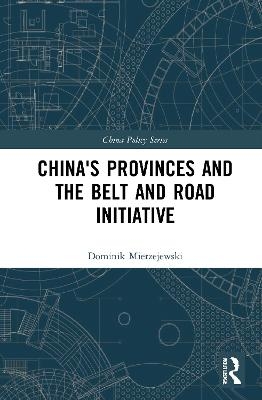
China's Provinces and the Belt and Road Initiative
Routledge (Verlag)
978-0-367-65490-0 (ISBN)
This book discusses the Belt and Road Initiative at the provincial level in China. It analyses the evolution of the role of local governments in Chinese foreign policy since the opening of China’s economy in 1978, showing how the provinces initially competed with each other, and how the central government was forced to react, developing more centralised policies. Unlike other books on the Belt and Road Initiative, which focus on the international aspects of the initiative, this book demonstrates the importance of the Belt and Road in reinforcing China’s unitary status and for managing and coordinating development at the local level as well as centre-province relations and province to province relations inside China.
Dominik Mierzejewski is an Associate Professor at the Department of Asian Studies, Faculty of International and Political Studies and chair of the Center for Asian Affairs at the University of Lodz, Poland. He specializes in the politics and foreign policy of China.
Acknowledgements Abbreviations list List of illustrations Introduction Chap 1 Understanding the Belt and Road Initiative through central-local perspectives 1.1. The BRI: between decentralization, horizontal competition and centralization nexus 1.2. Foreign policy, paradiplomacy and the Belt and Road Initiative 1.3. Domestication of the Belt and Road Initiative and provincial level governments Chap 2 The bridgeheads’ actions under the BRI: Heilongjiang and Yunnan case studies 2.1. Bridgeheads, middle ground and cross border governance within the Belt and Road Initiative 2.1.1. Defining middle ground, bridgeheads and peripheral diplomacy 2.1.2. Cross border governance: a theoretical understanding 2.1.3. Border areas and cooperation within the Chinese context 2.2. Heilongjiang: opening the North-East "old industrial" basis? 2.2.1. Local government and NDRC adoption of the BRI 2.2.2. Heilongjiang’s trade, investments, politics and biases 2.2.3. Heihe: the dilemmas of the cross-border cooperation 2.3. Managing Southwest China and cross-border governance in Yunnan province 2.3.1. Local government’s perspectives on the Belt and Road Initiative 2.3.2. Yunnan’s actions: money, perceptions and politics 2.3.3. Managing turbulent areas: cross-border governance in Ruili Chap 3 Sichuan and Chongqing: internal integration, Eurasian land bridge and foreign policy 3.1. Opening the landlocked: ways for western China development 3.1.1. The dilemmas of development in landlocked areas 3.1.2. Historical continuations and Open Up the West policy 3.1.3. Bringing the east and the west together: the YREB and the BRI 3.2. The most active BRI "player": Sichuan province 3.2.1. Sichuan discussing and planning its role in the Belt and Road Initiative 3.2.2. The international markets and politics in the Sichuanese "paradiplomacy" 3.2.3. Practicing local railway diplomacy: the district of Qingbaijiang 3.3. Chongqing’s close relations with the centre and its international activities 3.3.1. The Chongqing municipal’s perspective regarding the Belt and Road Initiative 3.3.2. Export markets, new technologies, capital rising and party-to-party relations 3.3.3. Developing the west through rail freight and Lianjiang New District Chap 4 Guangdong and Hainan: urbanization, maritime economies and strategic encounters under the Maritime Silk Road 4.1. The further opening up of opened areas: southern China and the Maritime Silk Road 4.1.1. Southern China and the 21st Century Maritime Silk Road 4.1.2. Urbanization and integration projects in the Greater Bay Area 4.1.3. The maritime economy and provinces’ sea border management 4.2. The Southern Gateway: the self-made Cantonese Belt and Road Initiative 4.2.1. Does the BRI matter? Guangdong’s responses to official policy 4.2.2. International markets, provincial lobbying and high-tech gateway 4.2.3. City multilateralism and market securitization: Guangzhou goes global 4.3 Hainan: an auxiliary player in China’s foreign policy? 4.3.1. Hainan serves China’s foreign policy: understanding the BRI in Haikou 4.3.2. Economic integration and limited international political outreach 4.3.3. Extension of Beijing’s bureaucratic cycles: Hainan and the South China Sea policy Conclusions Index
| Erscheinungsdatum | 18.10.2021 |
|---|---|
| Reihe/Serie | China Policy Series |
| Zusatzinfo | 13 Tables, black and white; 14 Line drawings, black and white; 13 Halftones, black and white; 27 Illustrations, black and white |
| Verlagsort | London |
| Sprache | englisch |
| Maße | 156 x 234 mm |
| Gewicht | 640 g |
| Themenwelt | Geschichte ► Teilgebiete der Geschichte ► Kulturgeschichte |
| Sozialwissenschaften ► Ethnologie | |
| Sozialwissenschaften ► Politik / Verwaltung | |
| Sozialwissenschaften ► Soziologie ► Empirische Sozialforschung | |
| Sozialwissenschaften ► Soziologie ► Spezielle Soziologien | |
| Wirtschaft ► Allgemeines / Lexika | |
| ISBN-10 | 0-367-65490-3 / 0367654903 |
| ISBN-13 | 978-0-367-65490-0 / 9780367654900 |
| Zustand | Neuware |
| Informationen gemäß Produktsicherheitsverordnung (GPSR) | |
| Haben Sie eine Frage zum Produkt? |
aus dem Bereich


